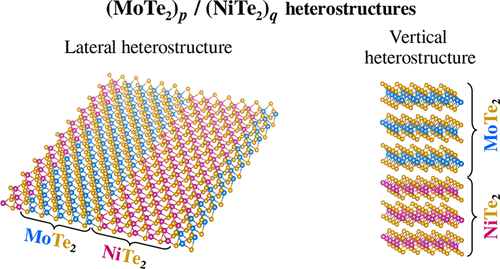当前位置:
X-MOL 学术
›
J. Phys. Chem. C
›
论文详情
Our official English website, www.x-mol.net, welcomes your
feedback! (Note: you will need to create a separate account there.)
Lateral and Vertical Heterostructures of Transition Metal Dichalcogenides
The Journal of Physical Chemistry C ( IF 3.3 ) Pub Date : 2018-01-17 00:00:00 , DOI: 10.1021/acs.jpcc.7b08256 Mehmet Aras 1 , Çetin Kılıç 1 , S. Ciraci 2
The Journal of Physical Chemistry C ( IF 3.3 ) Pub Date : 2018-01-17 00:00:00 , DOI: 10.1021/acs.jpcc.7b08256 Mehmet Aras 1 , Çetin Kılıç 1 , S. Ciraci 2
Affiliation

|
In this paper we investigate periodic lateral and vertical heterostructures of transition metal dichalcogenides (TMDs). Lateral heterostructures are constructed by the alternating metallic and semiconducting single-layer stripes of TMDs joined commensurately along their armchair edges and attain different states depending on the widths of constituents. While these heterostructures acquire a composite character with metallic state for narrow stripes, large stripes lead to the confinement of electronic states and function as metal–semiconductor junctions with a tunable Schottky barrier. The interface or boundary between constituent stripes has finite extension and allows charge transfer between them. On the other hand, the weak van der Waals interaction between layers sets the features of vertical heterostructures. Their interfaces are sharp: metal–semiconductor junction and Schottky barrier developed thereof can be induced even within a few layers. In the absence of dopants, we find minute charge transfer across the interface with negligible band bending in vertical heterostructures. The δ-doping of the semiconducting constituent by the metallic one forms strictly two-dimensional metallic electrons in a three-dimensional layered semiconductor and leads to crucial directionality effects and quantization of conductance. Our work unveils significant differences between lateral and vertical heterostructures.
中文翻译:

过渡金属二硫属元素化物的横向和垂直异质结构
在本文中,我们研究了过渡金属二卤化物(TMDs)的周期性横向和纵向异质结构。横向异质结构是由TMD的交替的金属和半导体单层条带沿其扶手椅边缘相称地连接而成,并根据成分的宽度而获得不同的状态。当这些异质结构获得窄条带的金属态复合特征时,大条带导致电子态的局限性,并充当具有可调肖特基势垒的金属-半导体结。组成条带之间的界面或边界具有有限的扩展范围,并允许它们之间进行电荷转移。另一方面,层之间的弱范德华相互作用设定了垂直异质结构的特征。它们的界面非常清晰:金属-半导体结及其形成的肖特基势垒即使在几层内也可以被诱发。在没有掺杂剂的情况下,我们发现整个界面上的微小电荷转移,垂直异质结构中的带隙弯曲可忽略不计。金属元素对半导体成分的δ掺杂在三维层状半导体中形成严格的二维金属电子,并导致至关重要的方向性效应和电导的量化。我们的工作揭示了横向和垂直异质结构之间的重大差异。金属元素对半导体成分的δ掺杂在三维层状半导体中形成严格的二维金属电子,并导致至关重要的方向性效应和电导的量化。我们的工作揭示了横向和垂直异质结构之间的重大差异。金属元素对半导体成分的δ掺杂在三维层状半导体中形成严格的二维金属电子,并导致至关重要的方向性效应和电导的量化。我们的工作揭示了横向和垂直异质结构之间的重大差异。
更新日期:2018-01-17
中文翻译:

过渡金属二硫属元素化物的横向和垂直异质结构
在本文中,我们研究了过渡金属二卤化物(TMDs)的周期性横向和纵向异质结构。横向异质结构是由TMD的交替的金属和半导体单层条带沿其扶手椅边缘相称地连接而成,并根据成分的宽度而获得不同的状态。当这些异质结构获得窄条带的金属态复合特征时,大条带导致电子态的局限性,并充当具有可调肖特基势垒的金属-半导体结。组成条带之间的界面或边界具有有限的扩展范围,并允许它们之间进行电荷转移。另一方面,层之间的弱范德华相互作用设定了垂直异质结构的特征。它们的界面非常清晰:金属-半导体结及其形成的肖特基势垒即使在几层内也可以被诱发。在没有掺杂剂的情况下,我们发现整个界面上的微小电荷转移,垂直异质结构中的带隙弯曲可忽略不计。金属元素对半导体成分的δ掺杂在三维层状半导体中形成严格的二维金属电子,并导致至关重要的方向性效应和电导的量化。我们的工作揭示了横向和垂直异质结构之间的重大差异。金属元素对半导体成分的δ掺杂在三维层状半导体中形成严格的二维金属电子,并导致至关重要的方向性效应和电导的量化。我们的工作揭示了横向和垂直异质结构之间的重大差异。金属元素对半导体成分的δ掺杂在三维层状半导体中形成严格的二维金属电子,并导致至关重要的方向性效应和电导的量化。我们的工作揭示了横向和垂直异质结构之间的重大差异。











































 京公网安备 11010802027423号
京公网安备 11010802027423号